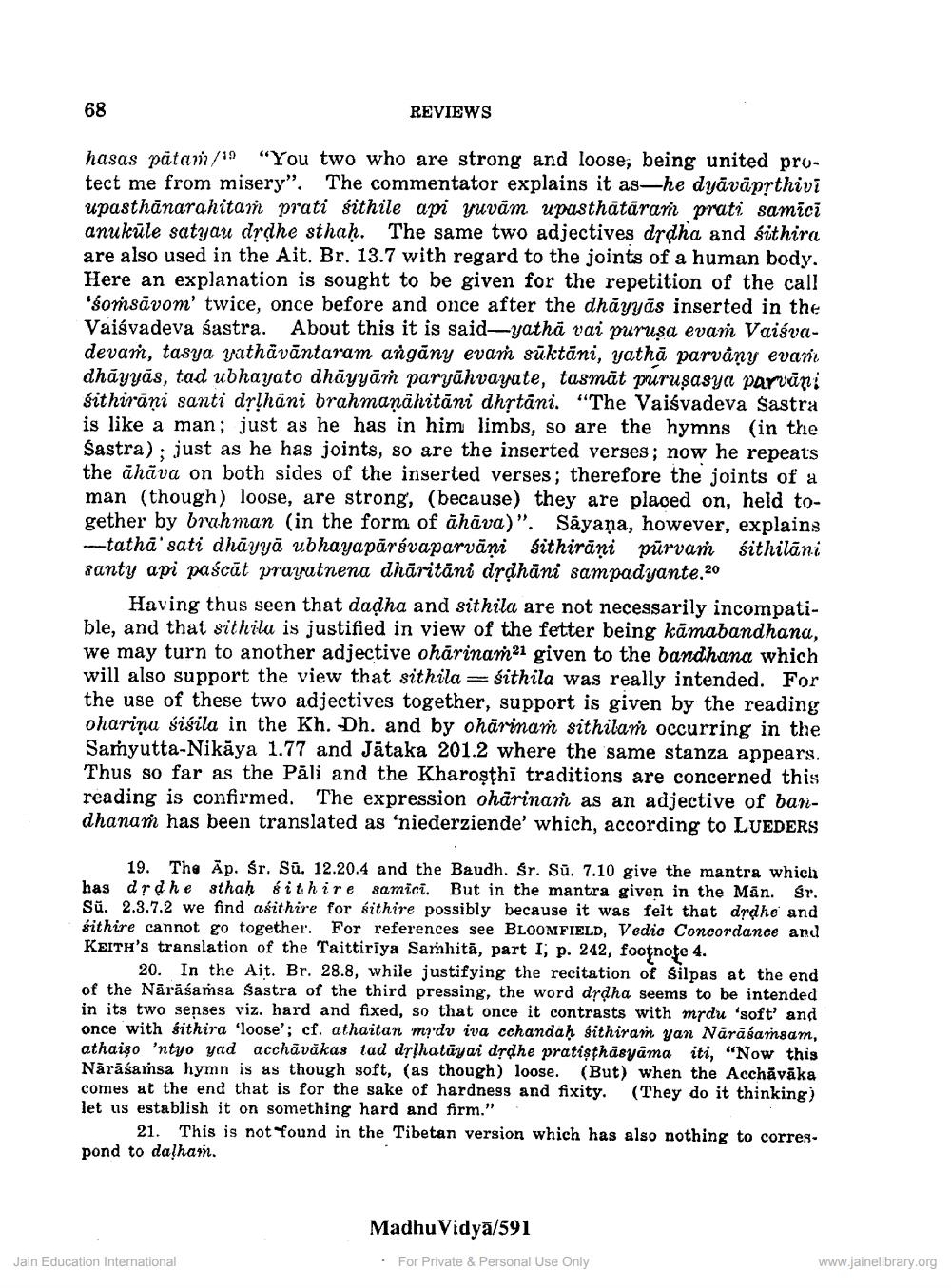________________
68
REVIEWS
hasas pätan/19 "You two who are strong and loose, being united prutect me from misery". The commentator explains it as—he dyāvāprthivi upasthānarahitam prati sithile api yuvām upasthātāran prati samici anukūle satyau drdhe sthaḥ. The same two adjectives drdha and sithira are also used in the Ait. Br. 13.7 with regard to the joints of a human body. Here an explanation is sought to be given for the repetition of the call 'soṁsāvom' twice, once before and once after the dhāyyās inserted in the Vaišvadeva sastra. About this it is said-yathā vai puruşa evam Vaišvadevam, tasya yathāvāntaram angāny evaṁ sūktāni, yathā parvány evan dhãyyās, tad ubhayato dhāyyām paryāhvayate, tasmāt puruşasya paruāri śithirāņi santi drlhāni brahmaņāhitāni dhrtāni. "The Vaiśvadeva Sastra is like a man; just as he has in him limbs, so are the hymns (in the Sastra), just as he has joints, so are the inserted verses; now he repeats the āhāva on both sides of the inserted verses; therefore the joints of a man (though) loose, are strong, (because) they are placed on, held together by brahman in the form of āhāva)". Sāyaṇa, however, explains -tatha' sati dhāyyä ubhayapārsvaparvāni sithirāņi pūrvaḥ śithilāni santy api paścāt prayatnena dhāritāni drąhāni sampadyante.20
Having thus seen that dadha and sithila are not necessarily incompatible, and that sithila is justified in view of the fetter being kämabandhana, we may turn to another adjective oharinaṁ21 given to the bandhana which will also support the view that sithila =śithila was really intended. For the use of these two adjectives together, support is given by the reading oharina sisila in the Kh. Dh. and by ohārinań sithilan occurring in the Saṁyutta-Nikāya 1.77 and Jätaka 201.2 where the same stanza appears. Thus so far as the Pāli and the Kharoşthi traditions are concerned this reading is confirmed. The expression oharinań as an adjective of bandhanam has been translated as 'niederziende' which, according to LUEDERS
19. The Āp. Śr. Sū. 12.20.4 and the Baudh. Śr. Sū. 7.10 give the mantra which has drdhesthaḥ śithire samici. But in the mantra given in the Mān. Sr. Sū. 2.3.7.2 we find asithire for sithire possibly because it was felt that drdhe and śithire cannot go together. For references see BLOOMFIELD, Vedic Concordance and KEITH's translation of the Taittiriya Samhitā, part I, p. 242, footnote 4.
20. In the Ait. Br. 28.8, while justifying the recitation of silpas at the end of the Näräsasa sastra of the third pressing, the word drdha seems to be intended in its two senses viz. hard and fixed, so that once it contrasts with mrdu 'soft' and once with sithira 'loose'; cf. athaitan mrdv iva cchandah sithiram yan Nārāśarsam, athaiso 'ntyo yad acchāvākas tad drlhatāyai drdhe pratisthasyāma iti, "Now this Nārāśassa hymn is as though soft, (as though) loose. (But) when the Acchăvăka comes at the end that is for the sake of hardness and fixity. (They do it thinking) let us establish it on something hard and firm."
21. This is not found in the Tibetan version which has also nothing to corres. pond to dalhan.
Madhu Vidyā/591
Jain Education International
• For Private & Personal Use Only
www.jainelibrary.org




